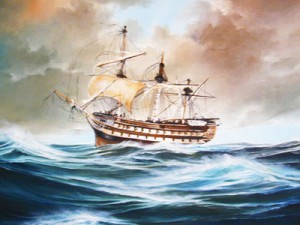Several famous writers wrote about Mexico despite having no direct geographic experience of the country.
One of the most famous was Jules Verne. Verne (1828-1905) popularized geography and was one of the pioneers of travel stories and science fiction.
Many his works have undeniably strong connections to geography, including:
- Twenty Thousand Leagues Under the Sea, a submarine voyage with Captain Nemo as the enigmatic hero
- A Journey to the Center of the Earth, in which Prof Lidenbrock and his nephew Axel descend into an extinct volcano in Iceland and discover an underground world
- From the Earth to the Moon, a vivid forerunner of future space travel
- Around the World in Eighty Days, where eccentric Englishman Phileas Fogg races round the world to try and win a bet
- Five Weeks in a Balloon, in which the heroes drift across unexplored areas in Central Asia and The Mysterious Island
Curiously, one of Verne’s first published stories, was set in Mexico, despite the fact that he had never visited the country. The original title Verne gave the story was North America. Historical studies. The first ships of the Mexican Navy. Meticulous as he was in regards to his geography, Verne was understandably aggrieved when the publisher changed North America to South America without even asking him! The story was first published in 1851, and later reworked as A Drama in Mexico.
The plot is set in 1825, shortly after Mexican Independence from Spain (1821). Mexico needed a strong navy to protect its extensive territory, which then stretched as far south as present-day Costa Rica. Antonio de Medina, the first Secretary of War & Navy, had fought at the Battle of Trafalgar in 1805. He persuaded the Mexican Congress to give high priority to the formation of a navy. Foreign interventions later in the century showed how prescient de Medina had been.
Verne’s story tells how the Mexican Navy obtained its first two warships, the former Spanish vessels Asia (later renamed the Congreso Mexicano) and Constanzia, following a mutiny by their crews.
The locales used in the story include:
- four Pacific coast ports: Acapulco, San Blas, Zacatula and Tehuantepec
- the villages or towns of Cigualan [Cihuatlán], Chilpanzingo [Chilpancingo], Tasco [Taxco] and Cuernavaca,
- the caverns of Cacahuimilchan [Cacahuamilpa]
- the pre-Hispanic site of Xochicalco
- Popocatepelt [Popocatepetl] Volcano
Read the original: Complete 1876 text in French as a webpage or Alternative complete text in French
If he had never visited Mexico, how did Verne acquire the range of geographic knowledge displayed in this story? Like many other geographers before and after, he relied on qualitative fieldwork—gaining his knowledge by talking to seafarers in his native port of Nantes, and through conversations with Jacques Arago, a Parisian friend who had fought in Mexico’s War of Independence.
Verne’s failure to visit Mexico certainly did not mean that his works had no significance to the people there. Indeed, as social historian William H. Beezley reminds us:
“His novel Around the World in 80 Days, published in 1873, had great popularity in Mexico, where many writers made comparisons between the characters in the novel and the nation’s first international scientific expedition in 1874 that also circumnavigated the globe…” Mexican National Identity: memory, innuendo and popular culture).
The main purpose of Mexico’s first international scientific expedition in 1874 was to observe, from Japan, the transit of Venus across the Sun.
Verne became the most widely read French author of all time, and one of the most translated authors anywhere in the world.
And what became of the Mexican Navy?
Today, the Mexican Navy (Secretaría de Marina) has over 55,500 personnel, 300 ships and 70 aircraft. Its main tasks are to protect oil reserves in the Gulf of Mexico, assist in the fight against drug traffickers, and aid in hurricane relief efforts.

Sorry, the comment form is closed at this time.